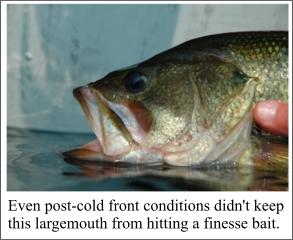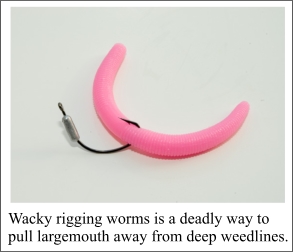|
 Cold Fronts & Deep Weedlines for Largemouth Cold Fronts & Deep Weedlines for Largemouth
By Tim Allard
Cold
fronts will challenge your angling skills. This is mainly because
fronts send most fish into a negative mood, and largemouth bass are
no exception. To successfully fool largies, you need to learn to
recognize what stage of a front you're fishing and match your
presentation accordingly. In most cases, fishing deep water is the
best strategy once a front has passed.
What's a Cold Front
A cold front can be described as the edge of a cold air mass
that moves in on a warmer air mass. The intensity of fronts will
vary. Fronts that move in quickly on warmer air masses cause
dramatic changes in weather. Rain, high winds and overcast skies
occur at the initial stages of most cold fronts. In extreme cases,
lighting and hail can be present. After the edge of cold air passes
typical weather conditions are: bright, blue skies, few clouds, low
humidity, and a drop in air temperature. These post-front conditions
might be pleasant for the angler, but they make for tough fishing.
Go Deep
It's no secret that edges attract largemouth and deep weedlines
often hold big bass. Deep weedlines are my largemouth sanctuary when
a cold front moves in. The reason is two fold. One, cold fronts
cause bass relating to shallow water to move to deeper water. This
increases the bass concentrated along deep weedlines as well as
other deep water structures, like timber. Second, bass that were
already relating to deep weedlines are rarely as affected by cold
fronts as shallow water bass, making deep-holding fish easier to
catch. Add these two facts together and it's tough to argue against
spending cold-front fishing time near deep weedlines.
Key Spots on Deep Weedlines
Largemouth concentrate on certain areas on deep weedlines. Spots
where cover and structure meet regularly hold bass. Fish are
attracted to the pockets created along the edge where weed growth is
interrupted by sunken wood or rocks. Inside and outside turns are
two other productive fish-holding spots on weedlines. Points
extending into deeper water featuring a weedline are often good bass
areas. Cuts are always worth fishing as they provide both cover but
also serve as a route from shallow to deep water. These form a long
pocket when they intersect a weedline.
Passing and Post-Front Weather
The early stages of a front bring wind and waves. If conditions
are safe, fishing can be hot during the pre-front conditions and the
beginning of the front. Bass seem to sense the impending changes and
feed heavily during the onset of a cold front. Once the air masses
have collided and the weather has stabilized, bass can have a
serious case of lock-jaw in these blue sky conditions.

Cool
Baits
In most cases finesse fishing is the best approach. This starts
by downsizing baits and going for natural presentations. Options
include wacky rigging Senko-style plastics or finesse worms on
either shaky-jig heads or on drop shot rigs. Work these baits slowly
and occasionally dead stick them on the bottom. This do-nothing
technique works particularly well in cold water conditions.
With wacky-rigged baits, don't be afraid to use weighted hooks or to
add a split shot a foot above the bait to increase its sink rate.
This might seem contrary to finesse fishing, but the weight gets the
bait in front of big, bottom-dwelling bass faster, bypassing smaller
ones often stationed higher in the water column.
Stacking the Odds in Your Favour
To increase your chances of getting largemouth to bite under tough
conditions, pay attention to details. Use scent products to make
your offering more appealing and ensure your presentation is as
natural looking as possible. Keep hooks extra sharp. Finally, pay
attention and focus; it's unlikely you're going to get a lot of
hits, so put yourself in the frame of mind to be ready to set the
hook when a fish bites.
Cold fronts are nasty to fish when they're blowing through and
post-front fishing can be extremely challenging. If chasing
largemouth, head for deep weedlines and use finesse baits. You'll
likely be a lot more productive than if you would have fished
shallow bays or looked under docks.
|